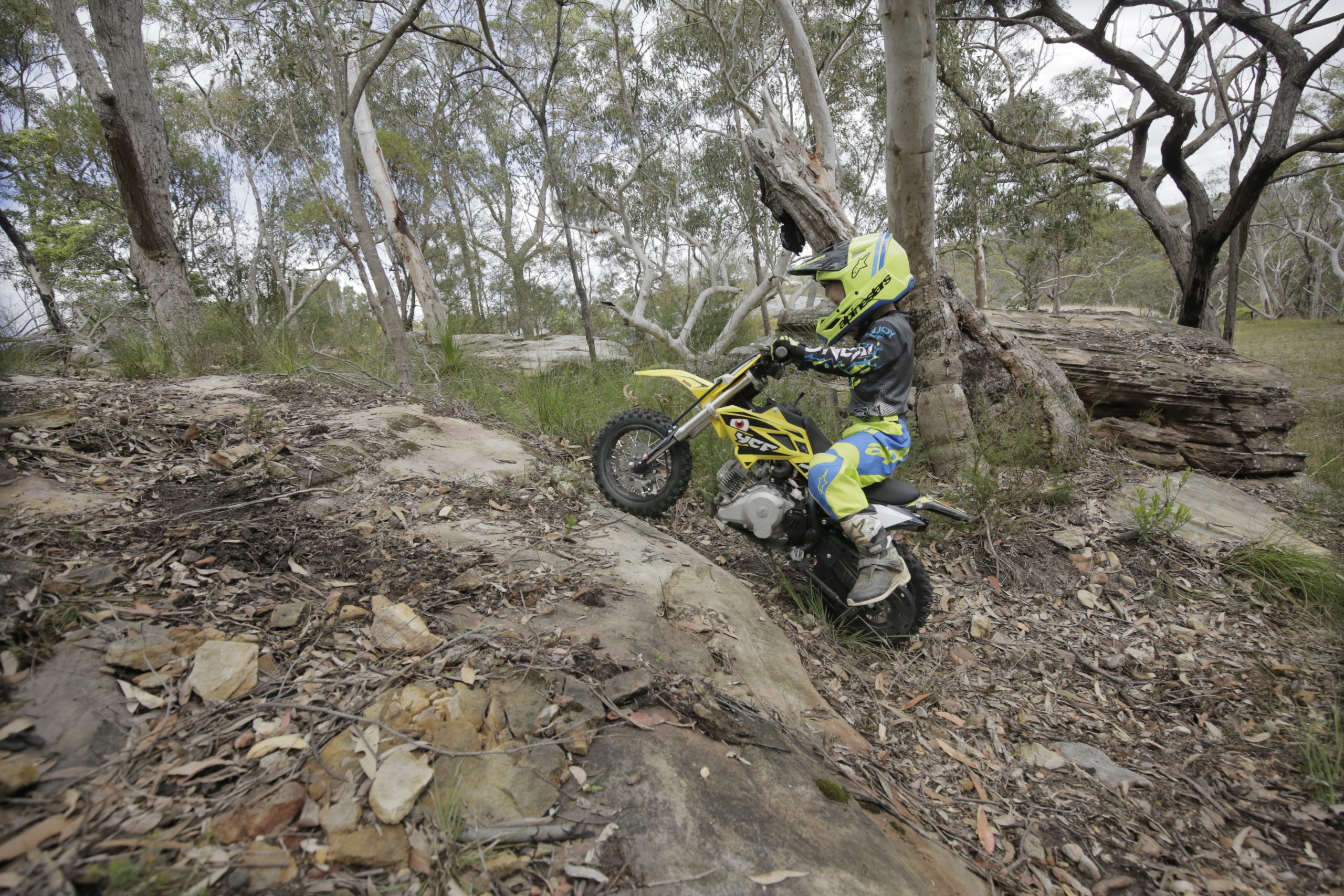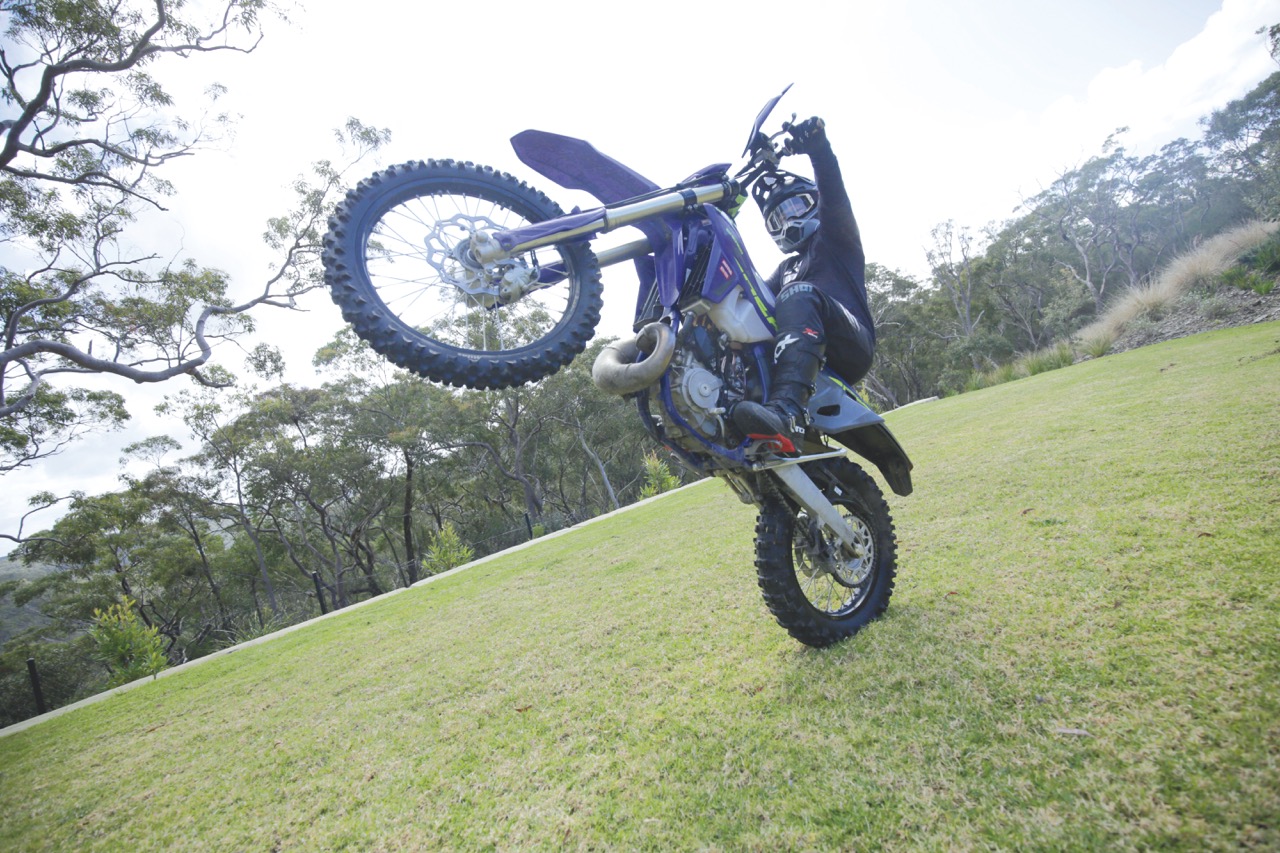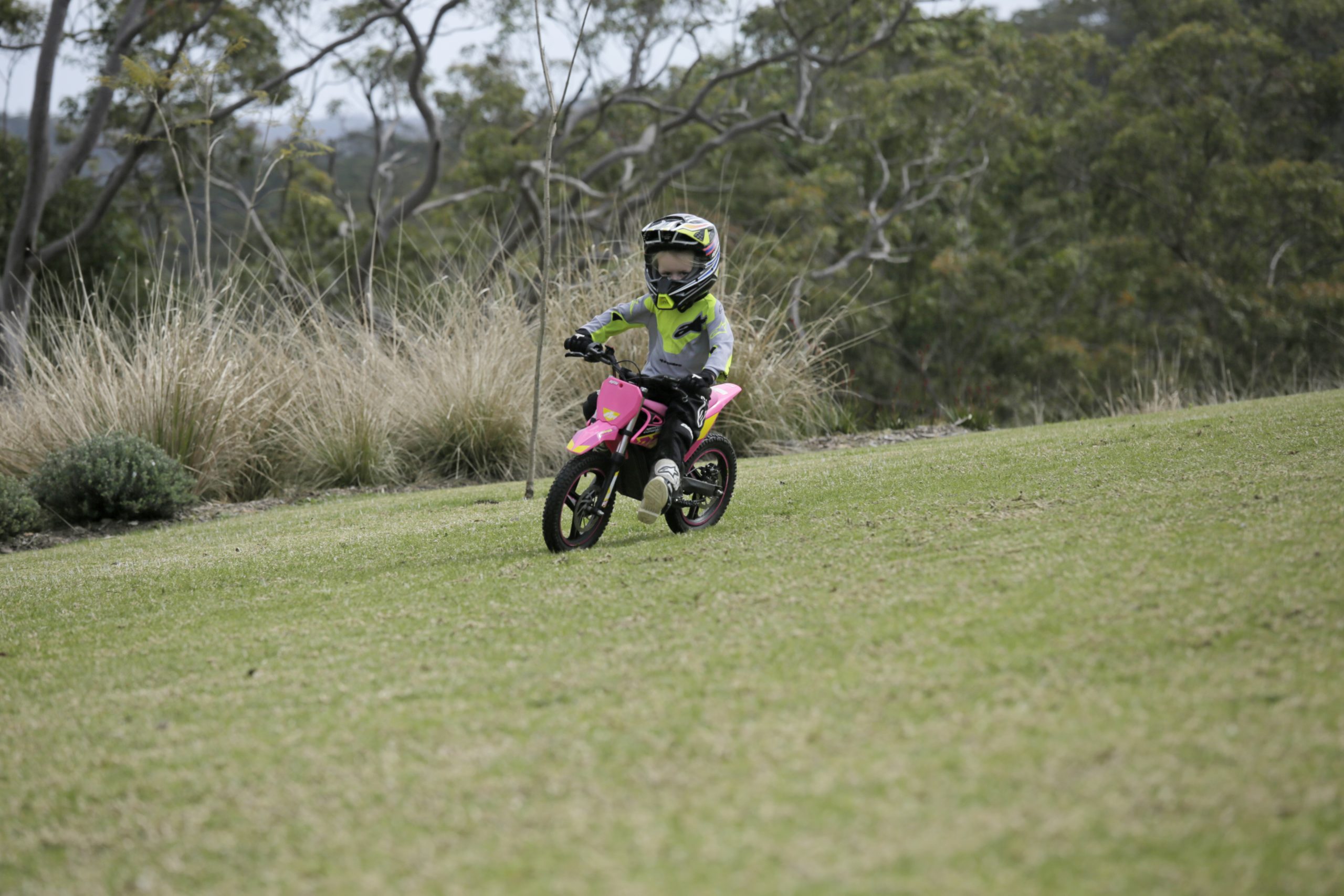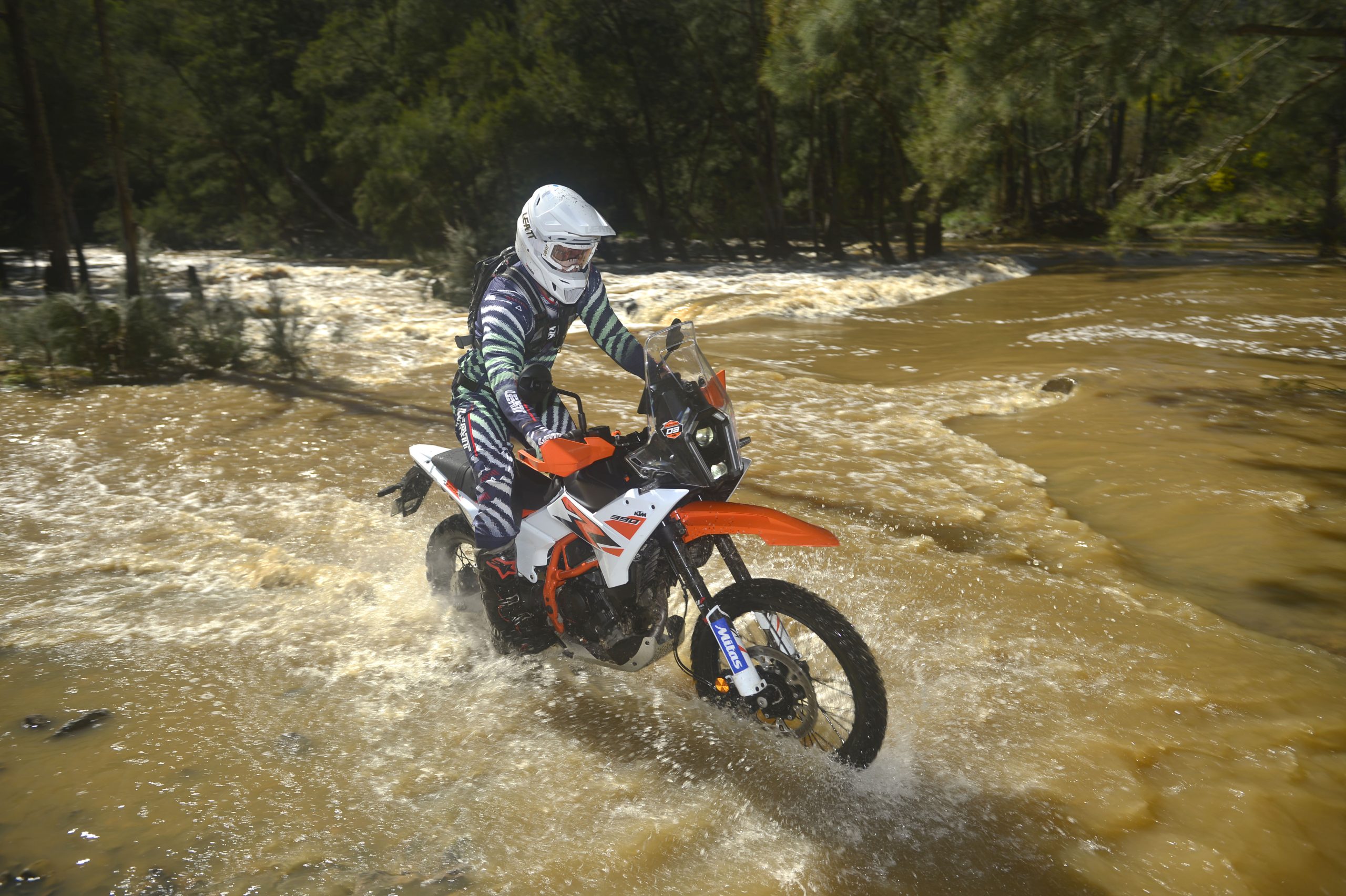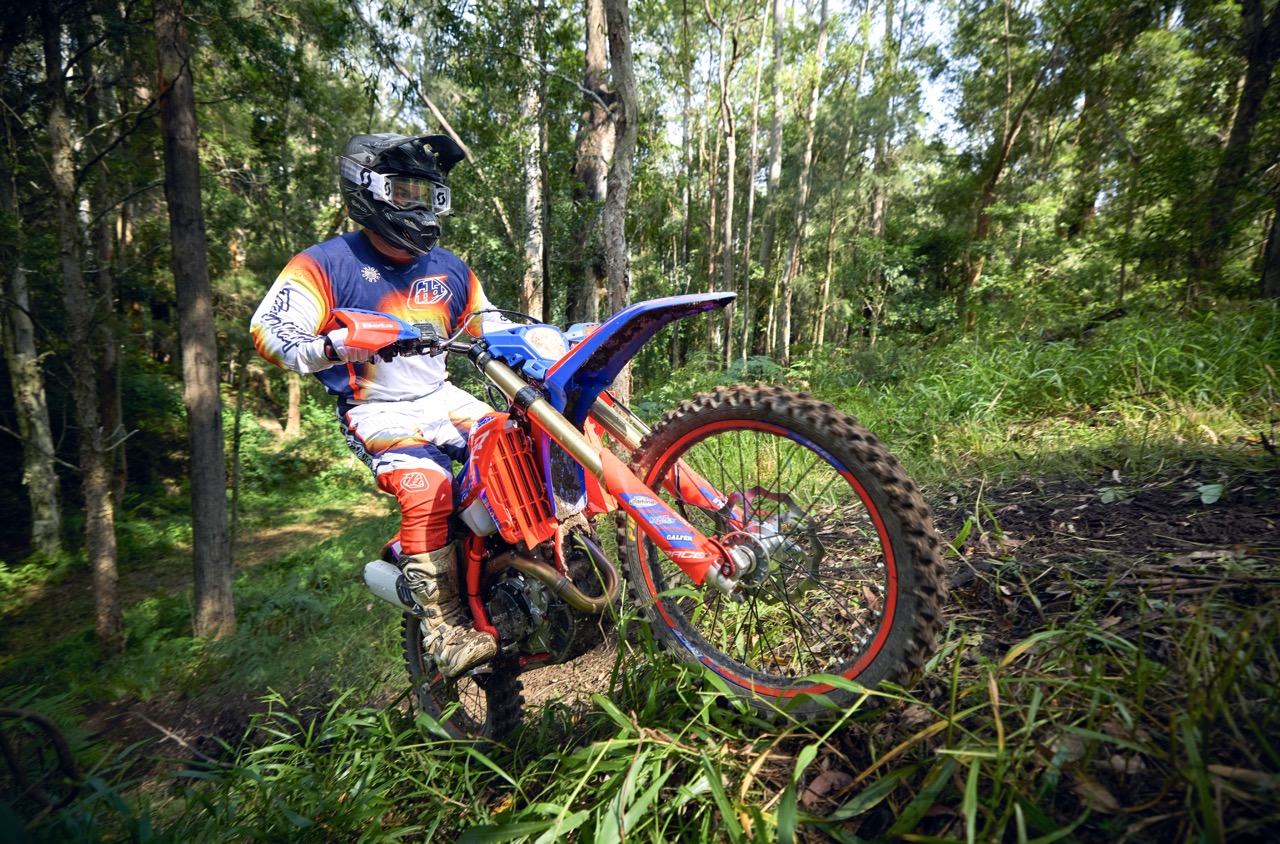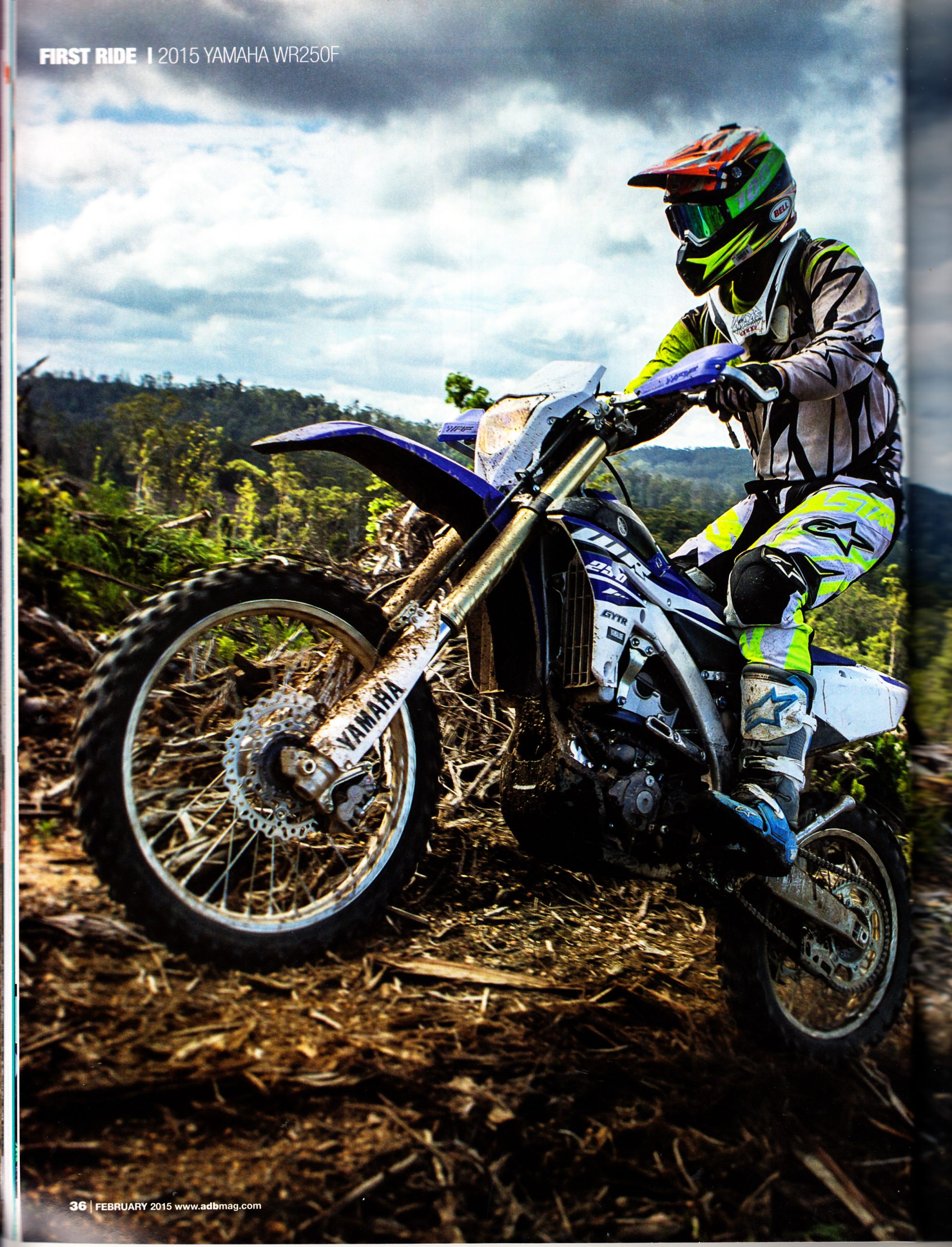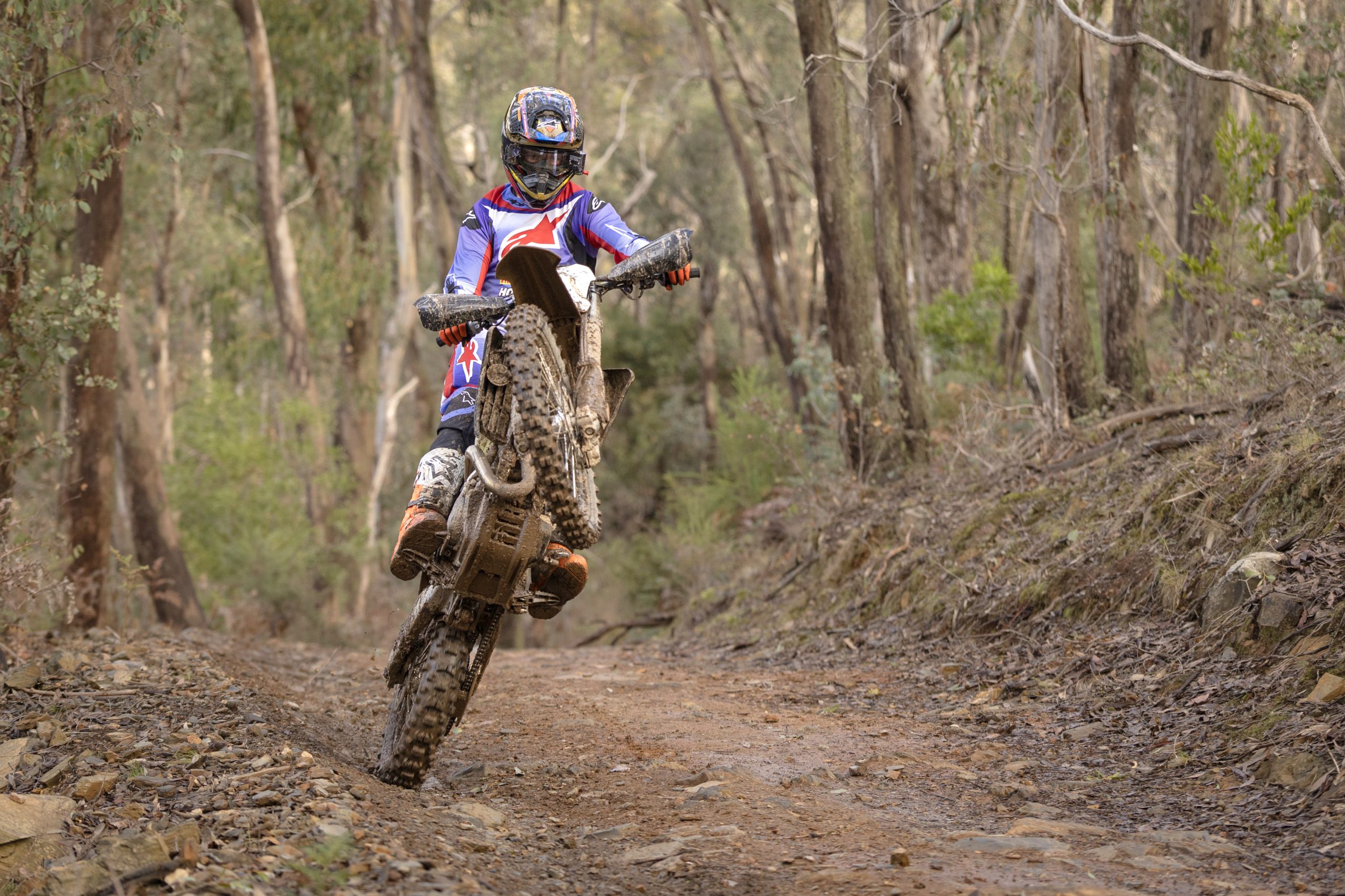Let’s start with the development of the 2024 Triumph TF 250-X. Triumph know their way around a piston but they did not have any experience in producing modern-day motocross bikes. They were first to put their hands up and admit they were not experts in motocross and were going to need some serious experience in the field to help them achieve a competitive bike.
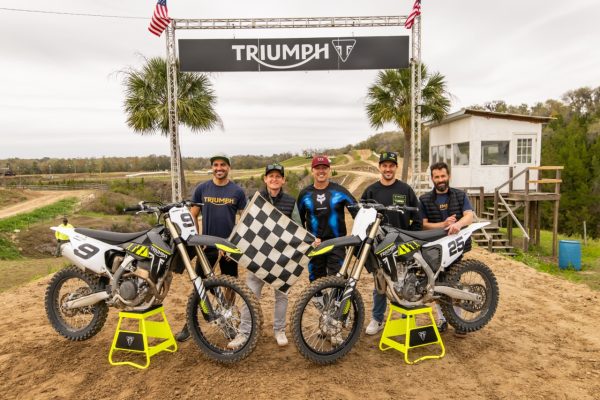
So they enlisted the help of some recognisable names. The G.O.A.T, Ricky Carmichael, the two Ivans – Cervantes and Tedesco and MXGP legend Clement Desalle all joined the development team which has ensured that Triumph nailed it from the outset. The amount of knowledge in this list alone, the engineers and technician they have worked with, the parts and gear that they have seen and tested is simply mind-blowing. All of these riders were at our launch to talk to about the bike, ride with us and maybe even pressure us into familiar mistakes on the track. They were great to ride with, gave us zero pressure and where a whole heap of fun out on the track.
Add to this the guys leading the racing teams, USA team principle Bobby Hewitt and Manager Stephen ‘Scuba’ Westfall, MXGP Team owner Thierry Chizt-Suzzoni and Vincent Bereni and the world class engineers on this project, you begin to realise just how serious Triumph is about the development of the 2024 Triumph TF 250-X.
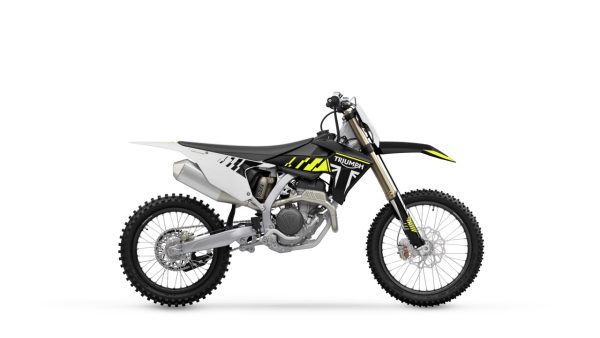
FRAME
“This was the base, this had to be right” RC said.
Triumph has set out to build their own bike not a copy or a rebadged bike, it was to be designed and built from the ground up. They put a lot of focus on the design and composition of the frame as they felt that this is the single most important part of the motorcycle. You can slap the best of everything else on to a bike but if the frame doesn’t work, you simply can’t succeed.
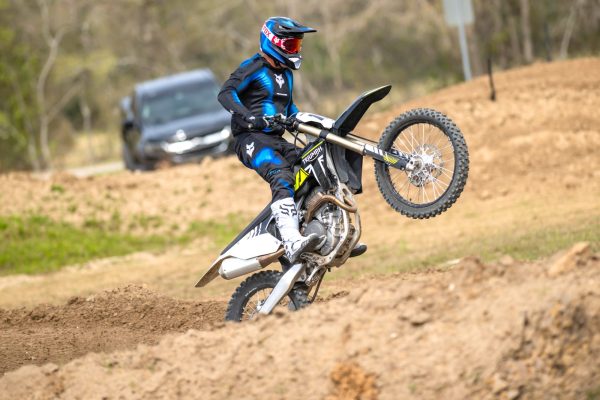
They tried every style and every material and ultimately decided on a high-strength, lightweight aluminium spine frame with twin cradle design for optimum balance performance, mass and flexibility. It has one-piece-forged outriggers and an extruded aluminium subframe and the entire frame has race optimised longitudinal, lateral and torsional stiffness. When combined with the KYB suspension this platform provided a very positive feel on the track.
It was very predictable, with no crazy deflections off bumps and a fantastic turning machine. There was no harshness that so often can be attributed to an alloy frame, especially one that is so young in its development. The attention to detail is next level and all frames are immaculately hand TIG-welded. The finished design also allows for an easy adjustment to the frame in the future to accommodate a larger fuel tank for their upcoming enduro model.
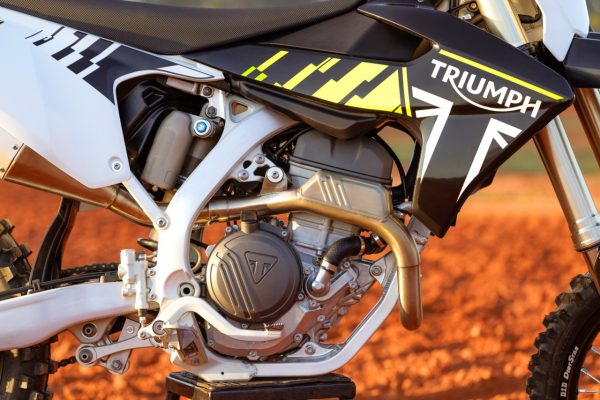
POWERPLANT
To say Triumph knows a little about engines is an understatement. They have had success in Supersport World Championships, the Isle of Man TT, the Daytona 200 and they still supply race-tuned 765cc triples, for the Moto 2 category at the MotoGP championships. They know the 250’s are a very competitive class, and every bit of power that can be rung out of them is vital if they are to compete against the other brands.
Power can be subjective to what is recognised as good or bad though. For example, I’m lazy rider these days that enjoys the power of a 450, if I need power, I turn the throttle and it’s there at any rpm. To me that is good power but others like living in the danger zone of the rev limiter. So building an engine that accommodates the majority would be difficult and Triumph knew this.
A lot of thought and testing went into this engine and the result is a quoted class-leading 48hp at 13,500rpm and boasting and impressive 29Nm torque that starts kicking in at 6000rpm and peaks at 9000rpm. Most impressively, this power barely signs off, peak horsepower only drops 2hp in the final 500rpm on offer. The power curve has no sharp climbs or declines, it’s very linear and impressive to look at.
The engine is fed by a Dellorto 44mm throttle body and a single Keihin injector. The race-tuned lightweight stainless steel exhaust system with integrated Helmholtz resonator in the header assists with this power delivery, and the additional side-resonator in the silencer for targeted noise attenuation produces a deep powerful exhaust note.
What does this all mean? There is usable power through a nearly 8000rpm range, the power is broad and you don’t have the 125 two-stroke effect where it is vital that you keep the engine working in a tiny 1500rpm range. On a 125 if you find yourself outside that sweet spot you’ll be scrambling for gears and on the clutch.
How does this relate to the track? It could trick people into thinking it feels a bit flat as there is no hard hitting spot throughout, until they realise that the power is constant and strong. You can turn the throttle and this little engine answers your call.
Miss a gear change and still in 3rd going into a tight corner? No problem, a tiny amount of clutch and you’re back in business. Of the 24 corners across the two tracks that I rode, 19 of them were done in 3rd, and four of them in 2nd. With my weight of 89kg having next to no trouble, the correct weight 250 rider will have no problems running taller gears.
At the same time this engine loves to be revved. Power is delivered at its highest point, the rev limiter acting as nothing more than a reminder that it’s time to change gears (for those riders that still havn’t been able to work out when you should be changing gears). This engine is a massive YES from me.
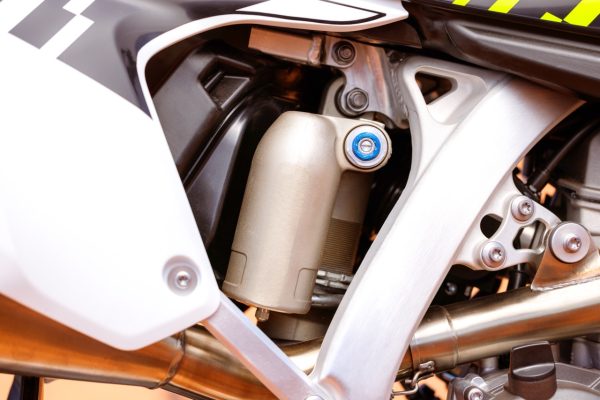
HANDLING
Triumph went with KYB as their suspension of choice. They use the KYB 48mm AOS coil fork, mounted in the Neken 7075-T6 forged and fully machined lightweight aluminium triple clamps and a KYB three-way piggyback shock with 50mm piston with a unique lightweight hollow shock mount.
Straight out of the box, with base setting clickers, the bike was pretty good and balanced. I wanted to get deeper into the day before I really started playing with clickers, fork heights, or ride heights to see what effect they had. Through the early part of the day I struggled a little with my riding (little mistakes here and there) that saw me off track a couple of times trying to push some speed. We then set my ride height at 102mm (a little taller than most other brands). It wasn’t that I couldn’t find and get into the corners, I just made those small mistakes that took me out of a corner and off the track.
After lunch we took a turn off the rear spring (104-105mm ride height) so I sat a little lower on the back and opened up the steering a little. Straight up on Diamondback which is the faster, more open track of the two, I saw a massive improvement in my turns, holding long fast ruts with ease. But there were some bumps forming coming down the hill which led into a fast long left handed rut and I felt the suspension was giving me a bit of a harsh, hard feeling (this is my confusion). It’s a feeling that makes you think maybe you need to go softer but this is completely the wrong way (I worked this out on a different, much quieter bike, with the same brand suspension).
We went four clicks harder on the compression and we were no longer sitting too low in the stroke, using the better portion of the fork. These two small changes saw my riding improve immensely. I was able to pick up and tip in to any rut I set my eyes on and I was loving it. We lowered the fork and played with some compression on the back, each time there was a noticeable and predictive change to the bike characteristics and handling.
I would have changed my ride height to where we started for Gatorback which is much tighter, but that’s the beauty of having a bike that does what you want from it. Knowing how these changes react, it would be easy on race day to know which changes to make to get the best out of the bike and not chase your tail for the whole day.
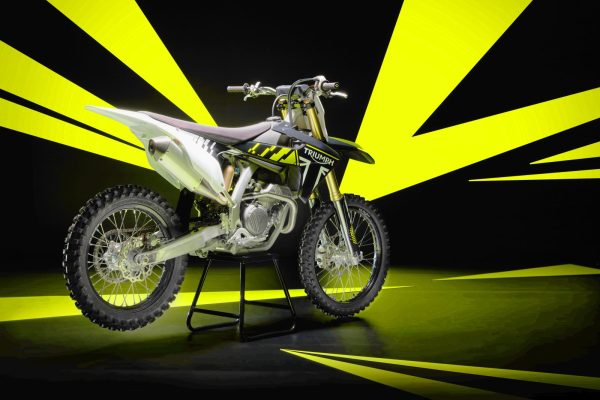
THE FEEL
Each brand of motocross bike has a certain feel, something you get accustomed to over the years. Sometimes other brands or just feel similar. The Triumph felt unique. When I first sat on the bike there really was this blank canvas feeling about it.
It was odd because I have never felt this before, I didn’t know what to expect.
First thing I noticed, it felt slightly wide where the seat met the shrouds but this quickly became unnoticeable as soon as I started spinning laps. The Pro Taper ACF Carbon Core bars are slightly wider than the bars I use but the bend was good for me as they were fairly straight and relatively low. There was very little vibration feedback through the bars, the seat height to pegs was very comfortable and width at the pegs was bang on for what I like. The seat has the slightest curve profile that is easy to move around on but allows you to find the central position with ease.

FINAL THOUGHTS
After hearing other reviews and riding myself, I think most are in agreement, this bike is pretty dam good! The bike has great, usable power for all riding levels, handles great and responds predictively to changes. At 104kg wet and 48hp it’s the lightest and best power to weight ratio in its class.
It’s a bloody great first attempt. It gets me excited to see what Triumph has in store for us next with a 450cc machine due to be released later this year and potentially an enduro range in 2025. If the 202 Triumph TF 250-X is any indication as to what we can expect from Triumph with future models, the competition better get ready, the British are coming!

THE FRUITS
Brembo brakes brakes all round, twin 24mm piston floating front caliper on a 260mm Galfer disc, single 26mm piston floating rear caliper on a 220mm Galfer disc. Plus a braided front brake line.
Brembo hydraulic clutch
ODI half waffle lock on grips
Pro Taper Bars
D.I.D Dirtstar 7000 series aluminium rims, black anodised finish
Triumph designed lightweight cast and machined aluminium hubs.
Pirelli Scorpion MX32 tyres
Neken Triple clamps
Bespoke hour meter
Self-coloured polypropylene bodywork mouldings
Acerbis fuel tank
DID 520 SDH Chain and JT sprockets
Pyramid seat cover material with optional Gripper seat cover
Tool free air filter access
Athena engine management system with ‘GET Power Assist’ traction control & launch control
A hell of a lot of buttons!
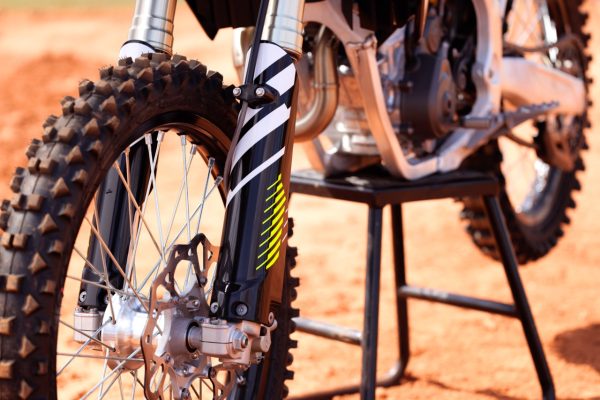
There’s also a list of accessory competition components in collaboration with Akrapovic for a strong power increase between 9,000-13,000rpm, XTRIG for hole shot device, Athena front guard mounted LC-GPA launch control unit and Triumph’s WiFi app engine map system. For this year the app will be limited to 10 pre-installed factory set maps, including a map optimised for the Akrapovic exhaust.
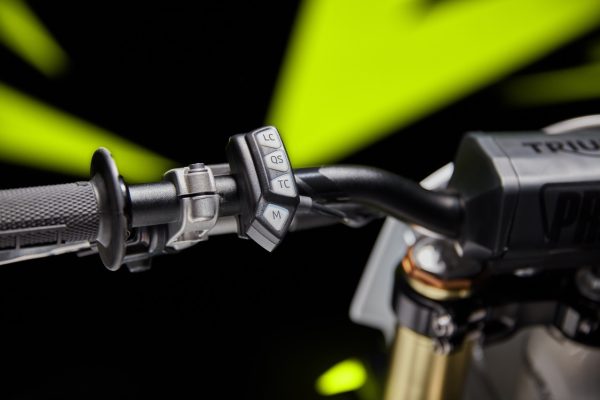
THE BIG QUESTION
So what do all the buttons do? I like to control the inputs to the bike myself and would like more time getting used to these assists at different tracks to get a full understanding of how beneficial they can be. All can be selected on the fly and each button is lit up in its designated colour when activated.
LC – Launch Control. I did try this out in a less than ideal rut. I found the power dropped off to much for my liking as it tried to control some wheel spin.
QS – Quick shift. Enables clutchless upshifting between 2nd & 5th gears. This one could be beneficial to a lot, for me not so much. I have always been able to power shift, on any bike but a lot of people can’t. I did try the QS and it does work. With my style of shifting I have weight on the gear lever and as I went up a small jump once this weight caused the bike to momentarily drop its power in readiness for a gear change that I did not intend.
TC – Traction Control. I did not try this. I was on a perfectly prepared loamy track, any wheel spin I got was intentional. I would like to try on a proper hard pack track.
M – Mode. There is only two options here. No light is your standard, more aggressive option. When activated it dials the power back slightly.
2024 TRIUMPH TF 250-X
ENGINE
Type DOHC single-cylinder four-stroke
Displacement 249.95cc
Bore & Stroke 78mm x 52,3mm
Cooling Liquid-cooled
Compression ratio 14.4:1
Fuel metering Dellorto throttle body, Athena EMS
Tank capacity 7L
Transmission Five speed
Clutch Wet plate multi, Belleville spring
DIMENSIONS
Wheelbase 1492mm
Seat height 960mm
Ground clearance NA
Claimed Weight 104kg (wet)
SUSPENSION
FRONT 48mm KYB fork, compression and rebound adjustable, 310mm travel
REAR KYB shock compression (high/low speed) and rebound adjustable, 305mm travel
BRAKES
Front Brembo twin 24mm piston caliper, 260mm disc
Rear Brembo single 26mm piston caliper, 220mm disc
RUNNING GEAR
Handlebar Pro Taper ACF Carbon Core
Front tyre 80/100 – 21 Pirelli Scorpion
Rear tyre 100/90 – 19 Pirelli Scorpion
PRICE & CONTACTS
RRP $14,250
BROWSER triumphmotorcycles.com.au
Warranty Three months
